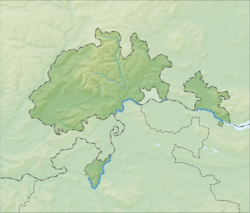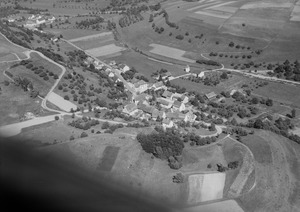Hofen, Switzerland facts for kids
Quick facts for kids
Hofen
|
||
|---|---|---|
 |
||
|
||
| Country | Switzerland | |
| Canton | Schaffhausen | |
| District | n.a. | |
| Area | ||
| • Total | 1.05 km2 (0.41 sq mi) | |
| Elevation | 474 m (1,555 ft) | |
| Population | ||
| • Total | 136 | |
| • Density | 129.5/km2 (335.5/sq mi) | |
| Postal code |
8242
|
|
| Surrounded by | Altdorf, Bibern, Opfertshofen, Tengen (DE-BW) | |
Hofen was once a small town, also called a municipality, in Switzerland. It was located in the canton of Schaffhausen. On January 1, 2009, Hofen joined with four other towns: Altdorf, Bibern, Opfertshofen, and Thayngen. Together, they became one larger municipality called Thayngen.
Contents
Hofen's Past: A Glimpse into History
Hofen is a very old place. The first time it was ever written about was in the year 1258. Back then, it was already known by the name Hofen.
Understanding Hofen's Coat of Arms
A coat of arms is like a special symbol or picture for a town or family. Hofen's coat of arms has a red background. On it, there is a golden lion standing up, with its tongue out and silver claws. The lion is holding a silver fleur-de-lis, which is a symbol shaped like a lily flower.
The Story Behind the Symbols
This coat of arms came from a man named Tobias Holländer. He was a mayor of Schaffhausen and lived in Hofen. His family originally came from Holland, which is why his last name was Holländer.
Tobias Holländer was born in Basel in 1636. He became mayor in 1683. In 1684, he bought land in Hofen and built a large house there. This house is known as the Holländer's house.
Symbols of Origin and Ambition
Tobias Holländer admired King Louis XIV of France. He even created his own small army, just like the king's army. His coat of arms showed where he came from and what he hoped to achieve.
The lion on the coat of arms represents the lion of the Dutch Republic, which was a country that existed in the Netherlands. The fleur-de-lis represents King Louis XIV. When Tobias Holländer built buildings for his private army in Hofen, he decorated them with his personal coat of arms. You can still see it there today. Over time, his personal coat of arms became the official symbol for the village of Hofen.
Hofen's Geography: Land and Location
Hofen is a small area. As of 2006, it covered about 1 square kilometer (0.4 square miles). Most of this land, about 73.1%, was used for farming. Forests covered about 8.7% of the area.
About 16.3% of Hofen's land had buildings or roads on it. A small part, about 1.9%, was non-productive, meaning it had rivers or lakes.
Where Hofen is Located
The village of Hofen is in the Reiat district. It sits in a valley called the Biber valley. Hofen is right on the border with Baden-Württemberg in Germany. It is located about halfway between Opfertshofen, Switzerland, and Büsslingen, Germany. You can find it on the main Swiss road that goes from Thayngen to Büsslingen.
Hofen's Population: A Look at Demographics
In the 2007 federal election, people in Hofen voted for different political parties. The most popular party was the SVP, which received 52.2% of the votes. The next two popular parties were the SP (25.4%) and the FDP (22.5%).
Historical Population Trends
Here is a table showing how Hofen's population changed over many years:
| Year | Population |
|---|---|
| 1850 | 123 |
| 1900 | 126 |
| 1950 | 140 |
| 1980 | 108 |
| 2000 | 127 |
See also
 In Spanish: Hofen para niños
In Spanish: Hofen para niños





